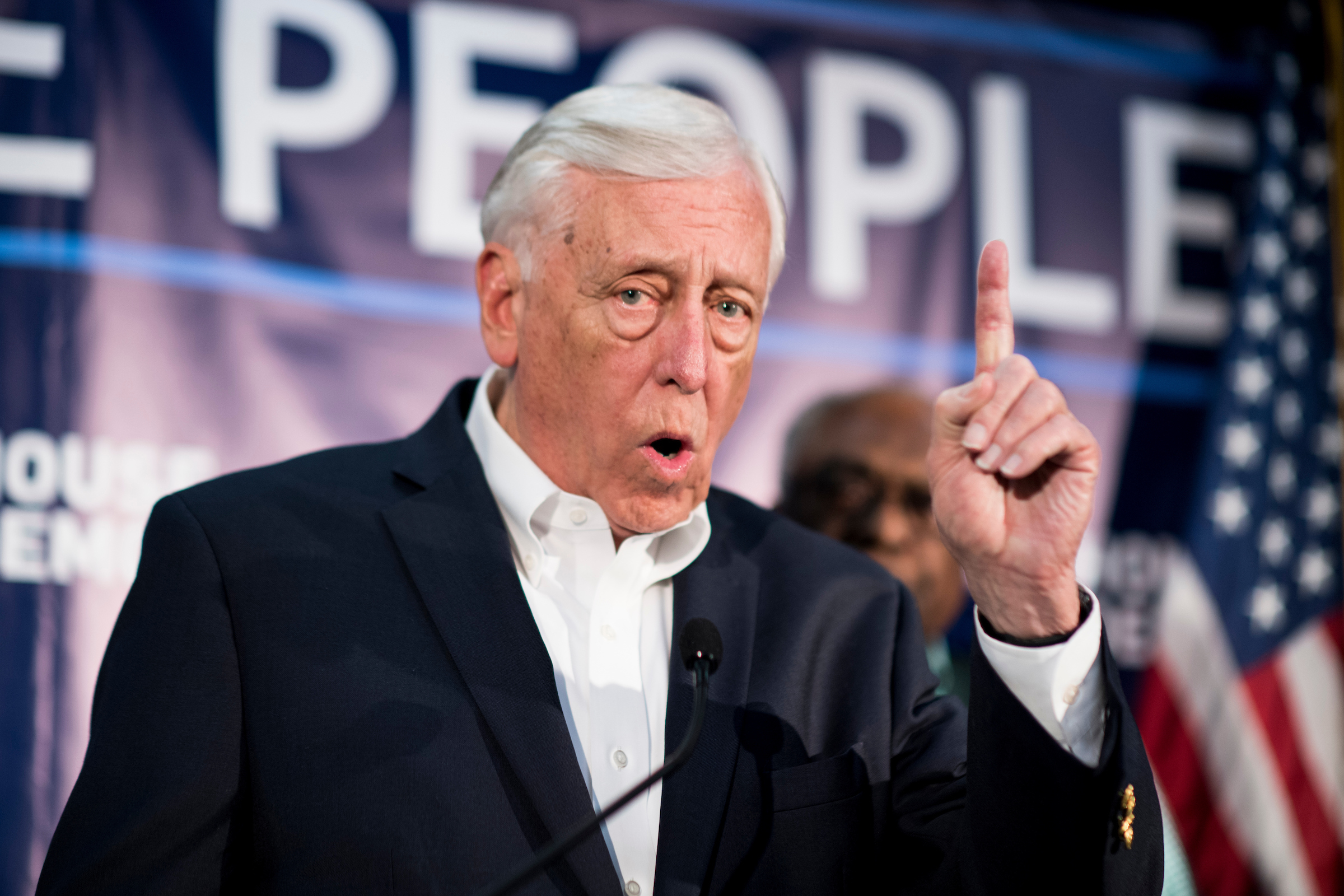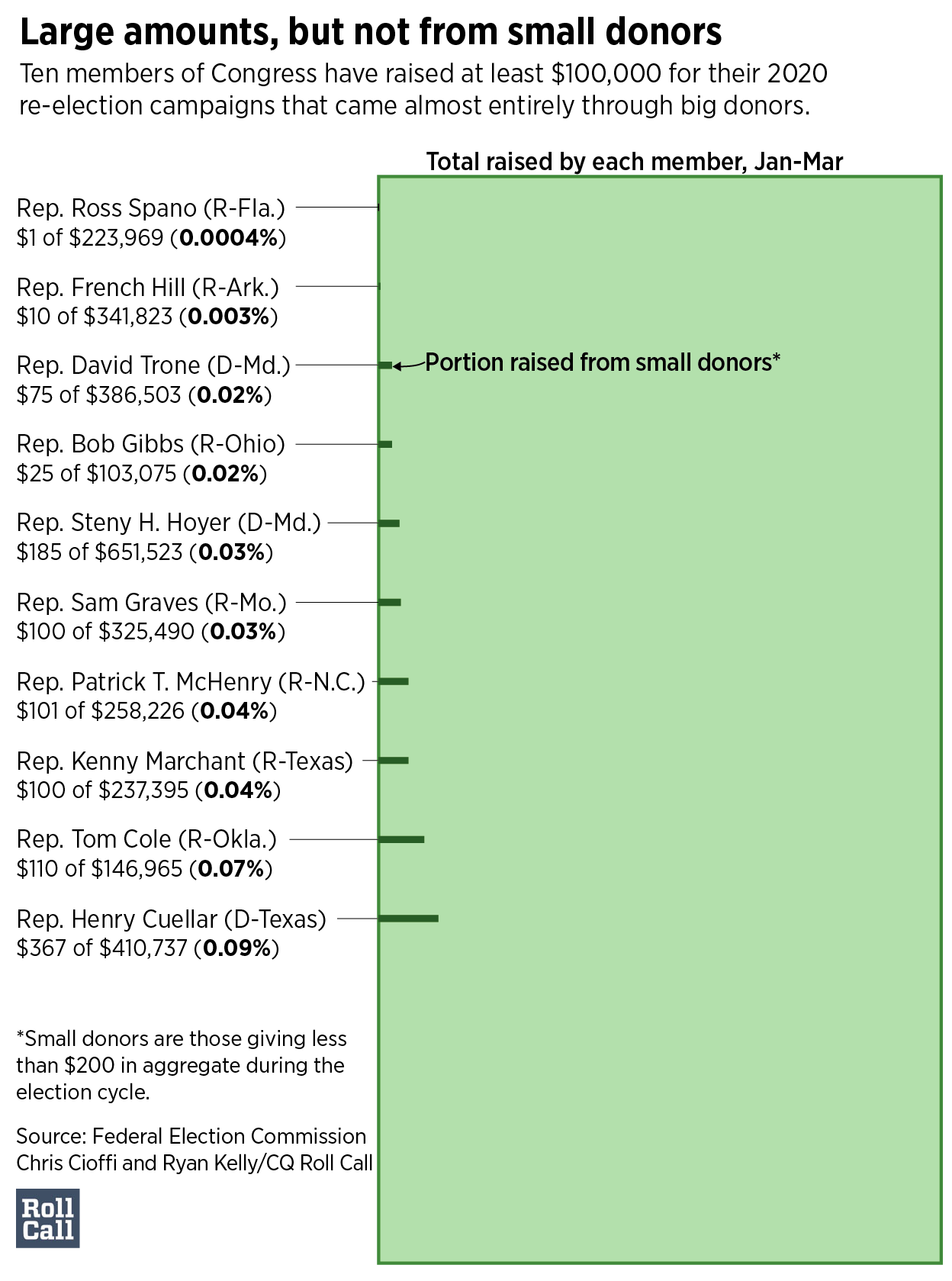Grasswho? Members raised hundreds of thousands, almost none from small donors
Democrats tout small-dollar contributions as grassroots support, but several raised less than $400 that way

Democrats have long touted the importance of raising small amounts of money from a large number of donors as a sign of political strength on the campaign trail and in Congress.
But recent campaign finance disclosures show some lawmakers — from both parties — raised next to no money from so-called small donors in the first three months of 2019 for their campaign accounts. The names of contributors giving less than $200 in the aggregate do not have to be included in reports to the Federal Election Commission, but the total received from all those “unitemized” contributions is disclosed.
[Small-dollar donors could hold the balance in 2020]
Democrats used small donors in the 2018 cycle to outraise their Republican counterparts, according to the Center for Responsive Politics. And the ability to get at least 65,000 different donors is being used this year as an entry test for the first televised Democratic presidential debates.
But some Democrats and Republicans who raised more than $100,000 during the first quarter got less than $400 of it from donors giving $200 or less.
For example, just $185 of the roughly $652,000 that House Majority Leader Steny H. Hoyer raised for his re-election fund from January through March came from unitemized contributions.
[Brett Kavanaugh could decide how redistricting is done]
The Maryland Democrat, who holds a safe blue seat, has received diminishing amounts from small-dollar donors for the last few cycles. In the first quarter of 2017, he raised $715 in unitemized contributions. Two years earlier, in 2015, it was $443.
That’s a contrast to back in 1998, when more than 20 percent of funds to Hoyer’s campaign committee came from small donations.
“It’s been dropping, which follows, perhaps, since he has been in a safe seat, and become a senior party leader over the years,” said Sheila Krumholz, executive director of the Center for Responsive Politics. “And so maybe small donors have dropped as his seat security and his stature has risen.”
Hoyer’s office said he fundraises both through his campaign committee and Ameripac, a leadership PAC that raises money to support other Democratic candidates.
“The majority of his grassroots fundraising is done through Ameripac,” Hoyer spokeswoman Mariel Saez said. She said 37 percent of the PAC’s contributions this cycle have come from small donors.
“Last cycle, 29 percent of his Ameripac fundraising came from unitemized contributions, if you do not include a pass-through fundraising program that Mr. Hoyer set up to bundle contributions for candidates in the most competitive districts,” she said. “In total, he had over 33,600 unique low donor grassroots donors to Ameripac.”
In the first quarter of 2019, Ameripac raised $519,000 and contributed $255,000 to other committees, FEC records show.
“He recognizes the importance of small donor contributions and will continue to work to fundraise to ensure House Democrats have all of the necessary resources to win in 2020,” Saez said.
Others raised $1 to $400
Other House members who took in some of the highest overall receipts, but received less than $400 in unitemized contributions, were Democrats Henry Cuellar of Texas and David Trone of Maryland. Republicans French Hill of Arkansas, Sam Graves of Missouri and Bob Gibbs of Ohio collected $10, $100 and $25, respectively, in unitemized contributions.
Florida GOP freshman Ross Spano collected just $1 in small donations in the first quarter of the year — the lowest for a House member.
“The $1 donation was a test to ensure our systems were working post-swearing in,” Spano spokeswoman Sandi Poreda said in an email. “Obviously, grassroots support is a critical component to a successful campaign; it was a significant factor with his first victory and we’re excited to see these efforts pick back up as we get further into the election cycle.”
Trone, also a freshman, spent $17.9 million of his own money on his 2018 race. In the first quarter of 2019, he contributed another $350,000 to his campaign, and received $75 from small donors.
Cuellar, Trone, Hill and Gibbs did not respond to requests for comment.
Not all candidates decide to focus a campaign message that reaches out to grassroots supporters and small donors because it can be challenging and expensive, according to Democratic campaign consultant Michael J. Fraioli.
“Candidates have to invest heavily on the front end to build up the digital or low-donor fundraising efforts,” he said.
But getting small donations, and refusing corporate PAC money, have increasingly been touted by candidates as a sign of independence from special interests, especially by those who won last fall with strong grassroots support.
An analysis by the Center for Responsive Politics found that House Democrats’ use of small donors in 2018 helped them outraise Republicans by $300 million.
One candidate who helped fuel that trend was New York’s Alexandria Ocasio-Cortez, who scored a primary upset last year of Rep. Joseph Crowley, then the No. 4 Democrat in the House. In the first three months of 2019, small-dollar donations made up 81 percent of the roughly $728,000 she raised.
Crowley, in contrast, raised less than 1 percent of his funds from small donors in the 2018 cycle.
Grassroots support
The Democratic Congressional Campaign Committee has sent a series of press releases criticizing the National Republican Congressional Committee’s “small dollar donor struggles,” and touting its candidates’ ability to raise money from the grassroots.
Having a large number of unitemized contributions can signal outreach to small donors and at least some grassroots support, said Rick Hasen, a University of California, Irvine professor and an expert in election and campaign finance law.
Hasen downplayed the importance of the small donation indicator, saying he doesn’t think “it shows all that much.”
“It is not surprising that safer incumbents might feel less of a need for this kind of outreach for their individual campaigns,” he said in an email. “Some of these might help fundraise for those small donors via DCCC or other organizations.”
It is also a possibility that candidates are still reaching out to a broad number of constituents and aren’t getting donations from them.
But such low unitemized donation totals do raise eyebrows.
“I think it’s fair to say, it’s pretty surprising,” Krumholz, said. “Given that they’re raising hundreds of thousands of dollars, that these members are receiving such paltry sums from donors of small amounts.”
In the first quarter of 2019, Speaker Nancy Pelosi’s campaign committee raised about 20 percent of its more than $1.3 million from unitemized individual contributors.
It’s easier to raise money more efficiently by reaching out to those with the deepest pockets. But some say it’s healthier for campaigns to show that they are reaching out to a broad spectrum of constituents and donors, including those who don’t have the means to give the maximum individual contribution of $2,800.
“It’s healthier because it shows they are not just catering to one class of people. And that they are seeking to represent all of their constituents,” Krumholz said.






